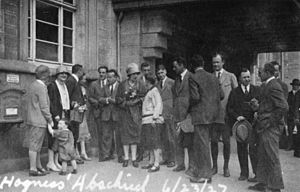Heinrich Gerhard Kuhn facts for kids
Quick facts for kids
Heinrich Gerhard Kuhn
|
|
|---|---|
| Born | 10 March 1904 |
| Died | 26 August 1994 (aged 90) Oxford, United Kingdom
|
| Nationality | German, British |
| Alma mater | University of Greifswald University of Göttingen |
| Awards |
|
| Scientific career | |
| Fields | Physicist |
| Institutions | Clarendon Laboratory Balliol College, Oxford |
| Thesis | Absorptionspektrum und Dissoziationswarmen von Halogenmolekül (1926) |
| Doctoral advisor | James Franck |
Heinrich Gerhard Kuhn FRS (March 10, 1904 – August 25, 1994) was a British physicist. He earned his doctorate degree at the University of Göttingen in Germany. His teacher was James Franck, who won the Nobel Prize for Physics in 1925.
In 1933, the Nazi Party came to power in Germany. Because of this, Heinrich Kuhn moved to Britain. He became a British citizen in 1939. He worked at the Clarendon Laboratory in Oxford, studying how light interacts with atoms. During World War II, he helped with important projects. These projects aimed to separate different types of atoms, which was vital for new technologies.
In 1950, he became the first physicist to be a fellow at Balliol College, Oxford. He also wrote important books about how atoms produce light.
Contents
Early Life and Education
Heinrich Gerhard Kuhn was born in Breslau, Germany, on March 10, 1904. He was the second son of Wilhelm Felix Kuhn, a lawyer. His older brother became a philosophy professor.
Heinrich spent much of his early life in Lüben. He went to school there and finished in 1922. He first planned to study chemistry at the University of Greifswald. But in 1924, he decided to switch to physics. He moved to the University of Göttingen, which was a famous place for physics studies. Many Nobel Prize winners had studied there.
Studying Physics in Göttingen
At Göttingen, Kuhn learned from famous scientists. He joined the research group of James Franck. Franck had recently published new ideas about how electrons move. Kuhn studied how chlorine and bromine gases absorb light. His work helped confirm an important idea in physics called the Franck–Condon principle. This work became his doctoral thesis in 1926.
After getting his doctorate, Kuhn continued his research. He became a lecturer at Göttingen in 1931. He studied how electric fields affect light from atoms, known as the Stark effect.
Life Changes and Moving to Britain
Heinrich Kuhn married Marie Bertha Nohl. Her father was a philosophy professor. Even though Heinrich's father was Jewish, Heinrich was raised as a Christian. However, when the Nazi Party took control in Germany in 1933, this did not matter. Kuhn was considered "non-Aryan" because he had two Jewish grandparents. He lost his university jobs, and his teaching rights were taken away.
His teacher, James Franck, resigned from his own job in protest. Franck did not want to dismiss his colleagues because of their race. Before leaving Germany, Franck helped his students find new jobs. He introduced Kuhn to Professor Frederick Lindemann, 1st Viscount Cherwell in Britain. Lindemann invited Kuhn to work at the Clarendon Laboratory at Oxford University.
Starting a New Life
Kuhn and his wife moved from Germany to Britain in August 1933. His relatives in Britain welcomed them. He received money from a company called ICI to support his research. His two sons were born in Britain. In 1939, Heinrich Kuhn became a British subject.
At the Clarendon Laboratory, Kuhn continued his research. He studied the very small details of light from elements like lithium and sodium.
Contributions During World War II
In 1940, Kuhn joined a team working on the British nuclear project, called Tube Alloys. This project was a secret effort to develop nuclear technology. It is interesting that foreign-born physicists like Kuhn were given this work. This was because they could not get security clearance for other top-secret projects like radar at first.
Kuhn's team studied a method called gaseous diffusion. This method helps separate different types of atoms. As part of this work, Kuhn traveled to the United States. He worked with the Manhattan Project, which was the American effort to build the atomic bomb.
Later Career and Legacy
After the war, Heinrich Kuhn stayed at Oxford. He continued his research on how atoms produce light. In 1938, he became a lecturer at University College, Oxford. He started teaching physics students in 1941.
In 1950, Balliol College, Oxford made him its first physics fellow. He was also the only refugee fellow at the college. In 1954, he was elected a Fellow of the Royal Society (FRS). This is a very high honor for scientists in Britain. He became a senior research fellow in 1969 and retired in 1971. He also received the Holweck Prize in 1967.
Germany later offered him his old job and pension back. But he chose to stay in Britain.
Important Textbooks
Kuhn had written a textbook in German called Atomspektren in 1934. In 1962, he published an updated version in English, called Atomic Spectra. This book was widely used by students and scientists for many years.
Heinrich Kuhn passed away in Oxford on August 26, 1994, after a long illness.


